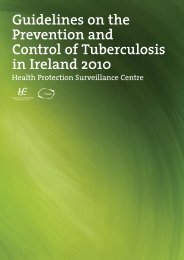The Management of Viral Haemorrhagic Fevers in Ireland - Health ...
The Management of Viral Haemorrhagic Fevers in Ireland - Health ...
The Management of Viral Haemorrhagic Fevers in Ireland - Health ...
Create successful ePaper yourself
Turn your PDF publications into a flip-book with our unique Google optimized e-Paper software.
<strong>The</strong> role <strong>of</strong> NPHORT is:• to carry out an <strong>in</strong>itial rapid epidemiological assessment <strong>of</strong> the potential PHEIC;• to co-ord<strong>in</strong>ate the descriptive and analytical epidemiological <strong>in</strong>vestigation, and the collection, collation anddissem<strong>in</strong>ation <strong>of</strong> <strong>in</strong>formation from the different areas and bodies <strong>in</strong>volved locally and nationally;• to evaluate the potential wider importance <strong>of</strong> the <strong>in</strong>cident locally, nationally and <strong>in</strong>ternationally anddeterm<strong>in</strong>e if it is a PHEIC;• to report its f<strong>in</strong>d<strong>in</strong>gs to the NFP with<strong>in</strong> 48 hours and then to produce regular update reports;• to advise the NFP on any local, regional, national and <strong>in</strong>ternational control measures needed <strong>in</strong> the light <strong>of</strong>the f<strong>in</strong>d<strong>in</strong>gs. This advice will be communicated by the NFP to the relevant parties, e.g. HSE, Department <strong>of</strong><strong>Health</strong>, other Government Departments, WHO etc;• to produce a f<strong>in</strong>al report, with lessons identified follow<strong>in</strong>g closure <strong>of</strong> any potential PHEIC <strong>in</strong>vestigation. Thisreport is for the NFP, and then for onward communication to WHO, and other <strong>in</strong>terested parties.5.4.2 Contact trac<strong>in</strong>gThis is done by public health <strong>in</strong> conjunction with the hospital team (Infectious Disease consultant/admitt<strong>in</strong>gcl<strong>in</strong>ician, <strong>in</strong>fection control, cl<strong>in</strong>ical microbiologist, and occupational health physician).A contact is def<strong>in</strong>ed as a person who has been exposed <strong>in</strong> the previous three weeks to a symptomatic<strong>in</strong>fected person or to a symptomatic <strong>in</strong>fected person’s secretions, excretions or tissues.<strong>The</strong> follow<strong>in</strong>g steps should be taken:• identify the type <strong>of</strong> VHF. Consider the stage <strong>of</strong> the illness and the level <strong>of</strong> viraemia at the time <strong>of</strong> exposure –<strong>in</strong>fectiousness <strong>in</strong>creases with progression <strong>of</strong> cl<strong>in</strong>ical illness;• determ<strong>in</strong>e if the patient has/had acute respiratory symptoms with <strong>in</strong>tense cough<strong>in</strong>g or sneez<strong>in</strong>g prior todiagnosis, and from this any possibility <strong>of</strong> potential airborne spread via blood ta<strong>in</strong>ted secretions;• trace the movements <strong>of</strong> the <strong>in</strong>dex patient for up to 3 weeks prior to onset <strong>of</strong> illness with a view to establish<strong>in</strong>gthe source <strong>of</strong> <strong>in</strong>fection;• from the <strong>in</strong>dex patient or his/her proxy, prepare a list <strong>of</strong> all potential contacts who are at risk <strong>of</strong> develop<strong>in</strong>gthe disease (Appendix K);• identify and <strong>in</strong>terview all potential contacts us<strong>in</strong>g a standardised form (Appendix L) and assign a riskcategory to these potential contacts (see Box 1 below);• use the high-risk contact surveillance form (Appendix M) to log the surveillance <strong>of</strong> high-risk contacts.Duration <strong>of</strong> contact trac<strong>in</strong>g and surveillance depends on the VHF identified (e.g. 21 days post last exposurefor Lassa fever, Marburg and Ebola, 13 days for CCHF).Note: If the patient had acute respiratory symptoms, this will then affect the type <strong>of</strong> surveillance needed –there may be a need to expand contact trac<strong>in</strong>g to <strong>in</strong>clude those who shared the same airspace. This will beassessed on a case-by-case basis. Please see Section 3.2 on mode <strong>of</strong> transmission and Appendix H for furtherdetails on the evidence for transmission <strong>of</strong> VHFs.5. Public <strong>Health</strong> <strong>Management</strong> <strong>of</strong> Imported VHF <strong>The</strong> <strong>Management</strong> <strong>of</strong> <strong>Viral</strong> <strong>Haemorrhagic</strong> <strong>Fevers</strong> <strong>in</strong> <strong>Ireland</strong>/HPSC 2012<strong>The</strong> risk categorisation determ<strong>in</strong>es the nature and type <strong>of</strong> actions needed subsequently.- 51 -
















